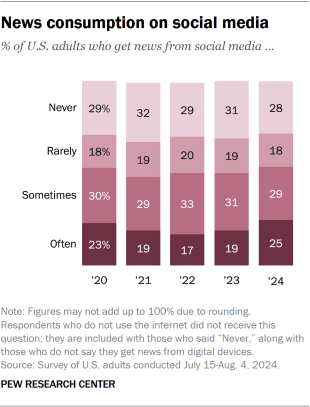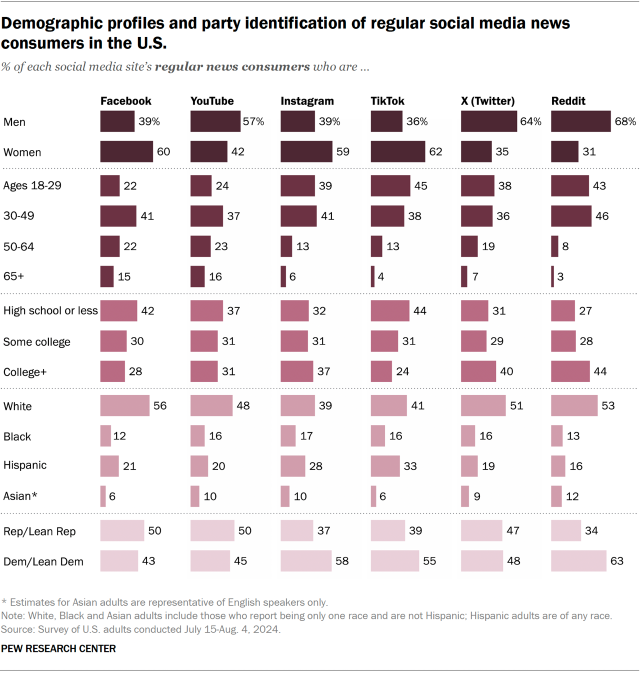Social media users probably won’t read beyond this headline, researchers say
A new study of 35 million news links circulated on facebook reports that more than 75% of the time they were shared without the link being clicked upon and read.

A study led by Penn State researchers revealed that more than 75% of people don’t click through links to read the full content prior to sharing the link on Facebook. Credit: VioletaStoimenova/Getty Images . All Rights Reserved .
November 19, 2024
By Ashley WennersHerron
UNIVERSITY PARK, Pa. — Congratulations. Reading this far into the story is a feat not many will accomplish, especially if shared on Facebook, according to a team led by Penn State researchers. In an analysis of more than 35 million public posts containing links that were shared extensively on the social media platform between 2017 and 2020, the researchers found that around 75% of the shares were made without the posters clicking the link first. Of these, political content from both ends of the spectrum was shared without clicking more often than politically neutral content.
The findings, which the researchers said suggest that social media users tend to merely read headlines and blurbs rather than fully engage with core content, appeared today (Nov. 19) in Nature Human Behavior . While the data were limited to Facebook, the researchers said the findings could likely map to other social media platforms and help explain why misinformation can spread so quickly online.
“It was a big surprise to find out that more than 75% of the time, the links shared on Facebook were shared without the user clicking through first,” said corresponding author S. Shyam Sundar , Evan Pugh University Professor and the James P. Jimirro Professor of Media Effects at Penn State. “I had assumed that if someone shared something, they read and thought about it, that they’re supporting or even championing the content. You might expect that maybe a few people would occasionally share content without thinking it through, but for most shares to be like this? That was a surprising, very scary finding.”
Access to the Facebook data was granted via Social Science One, a research consortium hosted by Harvard University’s Institute for Quantitative Social Science focused on obtaining and sharing social and behavioral data responsibly and ethically. The data were provided in collaboration with Meta, Facebook’s parent company, and included user demographics and behaviors, such as a “political page affinity score.” This score was determined by external researchers identifying the pages users follow — like the accounts of media outlets and political figures. The researchers used the political page affinity score to assign users to one of five groups — very liberal, liberal, neutral, conservative and very conservative.
To determine the political content of shared links, the researchers in this study used machine learning, a form of artificial intelligence, to identify and classify political terms in the link content. They scored the content on a similar five-point political affinity scale, from very liberal to very conservative, based on how many times each affinity group shared the link.
"We created this new variable of political affinity of content based on 35 million Facebook posts during election season across four years. This is a meaningful period to understand macro-level patterns behind social media news sharing,” said co-author Eugene Cho Snyder, assistant professor of humanities and social sciences at New Jersey Institute of Technology
The team validated the political affinity of news domains, such as CNN or Fox, based on the media bias chart produced by AllSides , an independent company focused on helping people understand the biases of news content, and a ratings system developed by researchers at Northeastern University .
With these rating systems, the team manually sorted 8,000 links, first identifying them as political or non-political content. Then the researchers used this dataset to train an algorithm that assessed 35 million links shared more than 100 times on Facebook by users in the United States.
“A pattern emerged that was confirmed at the level of individual links,” Snyder said. “The closer the political alignment of the content to the user — both liberal and conservative — the more it was shared without clicks. … They are simply forwarding things that seem on the surface to agree with their political ideology, not realizing that they may sometimes be sharing false information.”
The findings support the theory that many users superficially read news stories based just on headlines and blurbs, Sundar said, explaining that Meta also provided data from its third-party fact-checking service — which identified that 2,969 of the shared URLs linked to false content.
The researchers found that these links were shared over 41 million times, without being clicked. Of these, 76.94% came from conservative users and 14.25% from liberal users. The researchers explained that the vast majority — up to 82% — of the links to false information in the dataset originated from conservative news domains.
To cut down on sharing without clicking, Sundar said that social media platforms could introduce “friction” to slow the share, such as requiring people to acknowledge that they have read the full content prior to sharing.
“Superficial processing of headlines and blurbs can be dangerous if false data are being shared and not investigated,” Sundar said, explaining that social media users may feel that content has already been vetted by those in their network sharing it, but this work shows that is unlikely. “If platforms implement a warning that the content might be false and make users acknowledge the danger in doing so, that might help people think before sharing.”
This wouldn’t stop intentional misinformation campaigns, Sundar said, and individuals still have a responsibility to vet the content they share.
“Disinformation or misinformation campaigns aim to sow the seeds of doubt or dissent in a democracy — the scope of these efforts came to light in the 2016 and 2020 elections,” Sundar said. “If people are sharing without clicking, they’re potentially playing into the disinformation and unwittingly contributing to these campaigns staged by hostile adversaries attempting to sow division and distrust.”
So, why do people share without clicking in the first place?
“The reason this happens may be because people are just bombarded with information and are not stopping to think through it,” Sundar said. “In such an environment, misinformation has more of a chance of going viral. Hopefully, people will learn from our study and become more media literate, digitally savvy and, ultimately, more aware of what they are sharing.”
Other collaborators on this paper include Junjun Yin and Guangqing Chi, Penn State; Mengqi Liao, University of Georgia; and Jinping Wang, University of Florida.
The Social Science Research Council, New York, supported this research.
Ashley WennersHerron
- [email protected]
- https://www.psu.edu/news/
- Science and Technology
- Society, Arts and Humanities
- Faculty and Staff
- News of Record
- Publications
- University Park
- Bellisario College of Communications
- Department of Media Studies
- Media Effects Research Laboratory
- Fox Graduate School
- Latest News
Get the news by email
Numbers, Facts and Trends Shaping Your World
Read our research on:
Full Topic List

Regions & Countries
- Publications
- Our Methods
- Short Reads
- Tools & Resources
Read Our Research On:
Table of Contents
News consumption on social media, who consumes news on each social media site, find out more, social media and news fact sheet.
Digital sources have become an important part of Americans’ news diets – with social media playing a crucial role, particularly for younger adults. Overall, just over half of U.S. adults (54%) say they at least sometimes get news from social media, up slightly compared with the last few years.

Facebook and YouTube outpace all other social media sites as places where Americans regularly get news. About a third of U.S. adults say they regularly get news on each of these two sites.
Smaller shares of Americans regularly get news on Instagram (20%), TikTok (17%) or X, formerly known as Twitter (12%). And even fewer get news on several other sites, including Reddit (8%), Nextdoor (5%), Snapchat (5%), WhatsApp (5%), LinkedIn (4%), Truth Social (3%) and Rumble (2%).

News consumption by social media site
% of u.s. adults who regularly get news on each social media site.
Source: Survey of U.S. adults conducted July 15-Aug. 4, 2024.
PEW RESEARCH CENTER
Some social media sites – despite having relatively small overall audiences – stand out as destinations for news among many of their users. For example, 59% of X users get news there, as do a similar share of users on Truth Social (57%), the site owned by former President Donald Trump. On the other hand, only 14% of LinkedIn users regularly get news on that platform.
About half of TikTok users (52%) say they regularly get news on the site, up from 43% in 2023 and just 22% in 2020. The share of users who get news also has risen on several other sites, including YouTube and Instagram.
Social media sites by portion of users who regularly get news there
% of each social media site’s users who regularly get news there.
The people who regularly get news on different social media sites often differ by gender, age, political party and other factors. For example, women make up greater portions of regular news consumers on Nextdoor (64%), TikTok (62%), Facebook (60%), Snapchat (60%) and Instagram (59%), while men make up greater shares on Reddit (68%), X (64%), Rumble (60%), Truth Social (58%) and YouTube (57%).
News consumers on Snapchat, TikTok, Instagram, X and Reddit tend to be younger than those on other sites. Other patterns are unique to individual sites. For instance, 48% of news consumers on WhatsApp are Hispanic – much higher than on any other site. And LinkedIn has the largest portion of news consumers with a college degree (55%).
There also are partisan differences among those who regularly get news on some social media sites. Overwhelming shares of regular news consumers on Truth Social (88%) and Rumble (83%) are Republicans or Republican-leaning independents, as are half of those on Facebook and YouTube. On Instagram, WhatsApp, TikTok, Reddit and Nextdoor, news consumers are more likely to be Democrats or Democratic leaners. X news consumers are about evenly divided by party.
( Read the Appendix for data on the demographic and partisan makeup of U.S. adults who regularly get news from each social media site.)
- Facebook, YouTube, Instagram, TikTok, X (Twitter), Reddit
- Nextdoor, Snapchat, WhatsApp, LinkedIn, Truth Social, Rumble

This fact sheet was compiled by Research Assistant Christopher St. Aubin and Research Analyst Jacob Liedke .
Read the methodology and the topline .
Pew Research Center is a subsidiary of The Pew Charitable Trusts, its primary funder. This is the latest analysis in Pew Research Center’s ongoing investigation of the state of news, information and journalism in the digital age, a research program funded by The Pew Charitable Trusts, with generous support from the John S. and James L. Knight Foundation.
Follow these links for more in-depth analysis of news consumption on social media:
- News Platform Fact Sheet (Sept. 17, 2024)
- About half of TikTok users under 30 say they use it to keep up with politics, news (Aug. 20, 2024)
- How Americans Get News on TikTok, X, Facebook and Instagram (June 12, 2024)
- Many Americans find value in getting news on social media, but concerns about inaccuracy have risen (Feb. 7, 2024)
- 5 facts about how Americans use Facebook, two decades after its launch (Feb. 2, 2024)
- Americans are following the news less closely than they used to (Oct. 24, 2023)
- U.S. adults under 30 now trust information from social media almost as much as from national news outlets (Oct. 27, 2022)
- The Role of Alternative Social Media in the News and Information Environment (Oct. 6, 2022)
- Many Americans Get News on YouTube, Where News Organizations and Independent Producers Thrive Side by Side (Sept. 28, 2020)
Read all our reports and blog posts related to news platforms and sources .
CORRECTION (Oct. 16, 2024): The topline for this survey previously included incorrect figures (refer to topline for details). These have been updated in the topline and do not affect the overall findings in this analysis. Nothing on this page has been changed.
901 E St. NW, Suite 300 Washington, DC 20004 USA (+1) 202-419-4300 | Main (+1) 202-857-8562 | Fax (+1) 202-419-4372 | Media Inquiries
Research Topics
- Email Newsletters
ABOUT PEW RESEARCH CENTER Pew Research Center is a nonpartisan, nonadvocacy fact tank that informs the public about the issues, attitudes and trends shaping the world. It does not take policy positions. The Center conducts public opinion polling, demographic research, computational social science research and other data-driven research. Pew Research Center is a subsidiary of The Pew Charitable Trusts , its primary funder.
© 2024 Pew Research Center

IMAGES
VIDEO